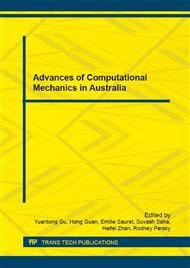[1]
A. Khennane, Manufacture and testing of a hybrid beam using a pultruded profile and high strength concrete, Australian Journal of Structural Engineering. vol. 10, no. 2 (2010) 145-156.
DOI: 10.1080/13287982.2010.11465040
Google Scholar
[2]
M.W. Ferdous, A. Khennane, O. Kayali, Hybrid FRP-concrete railway sleeper, in Advanced Composites in Construction 2013, ACIC 2013 – Conference Proceedings, pp.67-77, presented at ACIC 2013 – Conference Proceedings, Belfast, UK, 10 – 12 September (2013).
Google Scholar
[3]
O. Kayali, Fly ash lightweight aggregates in high performance concrete, Construction and Building Materials. vol. 22, no. 12 (2008) 2393-2399.
DOI: 10.1016/j.conbuildmat.2007.09.001
Google Scholar
[4]
V. Rangan, Design and manufacture of fly ash based geopolymer concrete, Concrete in Australia. vol. 34, no. 2 (2008) 37-43.
Google Scholar
[5]
M.H. Seleem, I.A. Sharaky, H.E.M. Sallam, Flexural behavior of steel beams strengthened by carbon fiber reinforced polymer plates – Three dimensional finite element simulation, Materials and Design. 31 (2011) 1317-1324.
DOI: 10.1016/j.matdes.2009.09.010
Google Scholar
[6]
A. Al-Rahmani, F.H. Abed, Numerical investigation of hybrid FRP reinforced beams, in 5th International Conference on Modeling, Simulation and Applied Optimization 2013 – Conference Proceedings, 2013, pp.1-6, Hammamet, Tunisia, 28 – 30 April (2013).
DOI: 10.1109/icmsao.2013.6552565
Google Scholar
[7]
ABAQUS, ABAQUS Documentation, Dassault Systèmes, Providence, RI, USA, (2011).
Google Scholar
[8]
Chakrabortty A, Design, manufacture, testing and analysis of filament-wound hybrid FRP-concrete beam, Ph.D. thesis, University of New South Wales in Canberra, (2012).
Google Scholar
[9]
S. Popovics, A numerical approach to the complete stress-strain curve of concrete, Cem. and Conc. Res 3 (1973) 583-599.
DOI: 10.1016/0008-8846(73)90096-3
Google Scholar
[10]
E. Thorenfeldt, A. Tomaszewicz, J.J. Jensen, Mechanical properties of high strength concrete and application in design, Proceeding of the Symposium of on Utilization of high strength concrete, Trondheim, 1987, pp.149-159.
Google Scholar
[11]
P.K. Sarker, Analysis of geopolymer concrete columns, Materials and Structures. 42 (2009) 715-724.
Google Scholar
[12]
T.H. Wee, M.S. Chin, M.A. Mansur, Stress-strain relationship of high-strength concrete in compression, Journal of Materials in Civil Engineering. vol. 8, no. 2 (1996) 70-76.
DOI: 10.1061/(asce)0899-1561(1996)8:2(70)
Google Scholar
[13]
D.A. Hordijk, Local approach to fatigue of concrete, Ph.D. Thesis, Delft University of Technology, (1991).
Google Scholar
[14]
J. Liu, R.G. Driver, A.S. Lubell, Rehabilitation and repair of reinforced concrete short columns with external steel collars, Report 281, Department of Civil and Environmental Engineering , University of Alberta, Edmonton, Alberta, Canada, (2008).
Google Scholar
[15]
J. Lee, G.L. Fenves, Plastic-damage model for cyclic loading of concrete structures, Journal of Engineering Mechanics. vol. 24, no. 8 (1998) 892-900.
DOI: 10.1061/(asce)0733-9399(1998)124:8(892)
Google Scholar
[16]
T. Jankowiak, T. Lodygowski, Identification of parameters of concrete damage plasticity constitutive model, Foundations of Civil and Environmental Engineering. no. 6 (2005) 53-69.
Google Scholar
[17]
S.W. Park, Q. Xia, M. Zhou, Dynamic behavior of concrete at high strain rates and pressures: II. numerical simulation, International Journal of Impact Engineering. 25 (2001) 887-910.
DOI: 10.1016/s0734-743x(01)00021-5
Google Scholar
[18]
Y.F. Li, C.T. Lin, Y.Y. Sung, A constitutive model for concrete confined with carbon fiber reinforced plastics, Mechanics. 35 (2003) 603-619.
DOI: 10.1016/s0167-6636(02)00288-0
Google Scholar


